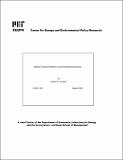| dc.contributor.author | Pindyck, Robert S. | en_US |
| dc.contributor.other | Massachusetts Institute of Technology. Center for Energy and Environmental Policy Research. | en_US |
| dc.date.accessioned | 2009-04-03T17:04:38Z | |
| dc.date.available | 2009-04-03T17:04:38Z | |
| dc.date.issued | 2001 | en_US |
| dc.identifier | 2001-001 | en_US |
| dc.identifier.uri | http://hdl.handle.net/1721.1/44973 | |
| dc.description.abstract | Because of the uncertainties and irreversibilities that are often inherent in environmental degradation, its prevention, and its economic consequences, environmental policy design can involve important problems of timing. I use a simple two-period model to illustrate these optimal timing problems and their implications for environmental policy. I then lay out and solve a continuous-time model of policy adoption in which the policy itself entails sunk costs, and environmental damage is irreversible. The model has two stochastic state variables; one captures uncertainty over environmental change, and the other captures uncertainty over the social costs of environmental damage. Solutions of the model are used to show the implications of these two types of uncertainty for the timing of policy adoption. | en_US |
| dc.description.sponsorship | Supported by the MIT Center for Energy and Environmental Policy Research. | en_US |
| dc.format.extent | 29 p | en_US |
| dc.publisher | MIT Center for Energy and Environmental Policy Research | en_US |
| dc.relation.ispartofseries | MIT-CEEPR (Series) ; 01-001WP. | en_US |
| dc.title | Optimal timing problems in environmental economics | en_US |
| dc.type | Working Paper | en_US |
| dc.identifier.oclc | 52314903 | en_US |
